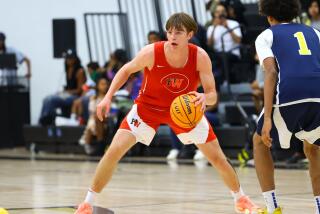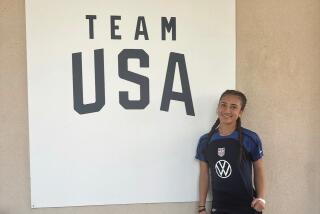ISSUE FOR THE COURTS : High School Basketball Coaches Are Divided Over How Much Emphasis Should Be Put on Off-Season Leagues
- Share via
The North Hollywood High basketball team has won or shared three consecutive league titles, but you won’t find Coach Steve Miller delivering a win-at-all-costs harangue from the bench during spring and summer league games. In fact, you won’t even find Miller on the bench.
Miller leaves that duty to assistant coaches Eli Essa and Mike Clancy while he sits in the top row of the bleachers, calmly making observations that he will put to use when the “real” season begins in the winter.
“Sitting up top gives you a better overall view of what is going on on the floor,” said Miller, who has 11 years of head coaching experience at the varsity and junior college level. “Plus the players need a break from the head coach and vice versa after the high school season ends.”
Whether their teams are coming off championship seasons or trying to rebound from trying times, coaches are divided on the importance of summer leagues.
“The summer and spring leagues are a good time for the players to familiarize themselves with each other, but I feel too much emphasis has been put on them,” Miller said. “I’ve seen no correlation between playing well in the summer and playing well in the fall.”
Except for this year, when a veteran North Hollywood team was 14-1 during the combined spring and summer leagues, the Huskies have traditionally done poorly during the off-season, averaging about five wins and 20 losses, according to Miller.
“I think some teams that excel during the summer have a tendency to burn out in the middle of the regular season,” Miller said. “I think they’re just too intense during the summer and they’re worn down in the winter.”
Hart Coach Greg Herrick, who is entering his third season at the Newhall campus, doesn’t buy that theory.
“I’ve seen too many players created in the summer leagues to think it’s not (important),” said Herrick, who guided Cleveland High to two City Section 3-A Division championships during his tenure at the Reseda campus from 1979-85. “I’ve seen players go from bench warmers or role players to starters during the summer months time and time again.”
Bret Saberhagen, a pitcher with the Kansas City Royals, was a prime example.
Saberhagen was expected to be the seventh or eighth man on the basketball team after his junior baseball season in 1981, but he performed so well in summer-league play that he was the starting point guard when the Cavaliers won their second consecutive 3-A title.
“His case was not a freak thing either,” Herrick said. “It happens all the time.”
Miller’s casual attitude stems from several factors, two of which are unique to City Section coaches.
The first is a City rule prohibiting coaches from holding official practices during the summer--the Southern Section has no restrictions--and secondly, many Valley players are bused from the inner city during the school year but lack consistent transportation during the summer.
“It definitely makes a difference in your approach,” El Camino Real Coach Mike McNulty said. “You can’t expect the kids to perform at a high level when they’re not practicing on a regular basis.”
McNulty, who has coached at El Camino Real for eight seasons, added that it has become a necessity for many Valley schools to play in summer leagues simply because they have several bused-in players in their lineups.
“If they don’t play for you during the summer, the local schools will recruit them to play for them,” he said. “You have to do it to keep up with everybody else.”
Because of the lack of transportation, some coaches, such as Jim Woodard of Taft, frequently have to scramble to put together the minimum five-man team for summer-league games.
“We’ve had times this summer where I was bringing the kids up from the junior-varsity level so we wouldn’t have to forfeit,” Woodard said. “It’s just one of those things that happens during the summer.”
The infrequency of a set lineup also has influenced Miller’s laid-back approach.
Some of his players--such as Harry Marks and Duane Braxton--played American Legion baseball this summer and others--such as Dana Jones--have been involved in all-star tournaments.
Often, their schedules prevented them from participating in summer-league games but Miller was not concerned.
“I can’t coach with the same intensity in the spring and summer as I do in the fall,” he said. “I wouldn’t last very long in coaching if I did that. And I don’t expect the kids to have the same intensity during the spring and summer that they have in the fall.”
Woodard, who is entering his ninth year as Taft’s head coach, agreed with Miller.
“The summer is much more relaxing,” he said. “I don’t worry about the games. During the regular season, I have a constant knot in my stomach from December until March.”
Howard Levine, who is entering his fourth season at Grant, said that he constantly has to remind himself that there is not a lot at stake during the summer, that a playoff berth is not on the line when a game is in the balance.
“I have to fight myself sometimes because I’m a very competitive person,” Levine said. “If I’m playing my mother in checkers, I want to win. . . . But I think the kids need a break from the really intense coaching during the summer.”
Although coaches vary in their approach to spring and summer leagues, they agree that the leagues serve a useful purpose.
“It’s a chance for a kid to show a coach what he can do,” Herrick said. “It’s a chance for a borderline player to earn a spot on the team.”
During the regular season, it’s almost impossible for a team’s ninth or 10th player to get playing time--except during blowouts--but most coaches give their players equal time during the spring and summer.
“It’s a lot like a tryout,” Reseda Coach Jeff Halpern said. “It gives coaches a chance to look at players and it gives players a chance to familiarize themselves with each other.”
Levine added that the spring and summer leagues are a good way for a junior-varsity player to break in at the varsity level.
“Summer leagues can help a young player get used to playing at that caliber,” Levine said. “They can show him what it takes to compete at the varsity level.”
Joe Dunn, the Bell-Jeff coach for the past 11 seasons, said he has one goal during summer league play: to be the most improved team in the league when it ends.
“You always want to win,” Dunn said. “But you don’t worry about wins and losses. The summer is a time to pick your combinations and find out who plays well together. No one remembers in March what your summer-league record was.”
If there is a criticism of spring- and summer-league basketball, it is that the players don’t have a chance to rest--that they are being forced to play the sport year-round.
Some coaches, for instance, won’t let an athlete play basketball in the fall if he doesn’t play in the summer, which is not a concept Miller shares.
“I love the sport,” Miller said. “I’m a big fan of it. But there is a time when you need to take a break from it. And I think the players need a break too. If a kid doesn’t want to play in the summer, I don’t think he should be punished for it.”
Herrick, Levine and Dunn, however, view things differently.
“It’s not like the kids are playing basketball eight hours a day,” Dunn said. “We practice two hours a day, three days a week and play one game a week, which takes no more than two hours of a kid’s time. Our practices are from six until eight in the morning so the kid’s got the rest of the day to do whatever he wants.”
Herrick and Levine both said that players should welcome the chance to develop their skills during the spring and summer.
“If a player is going to burn out playing basketball during the summer, he shouldn’t be trying to play at the varsity level,” Levine said. “You should love basketball to play at that level. You should be all for playing in a league.”
“We look at it as another season, as another opportunity to get some experience,” Herrick said. “It’s only a couple of hours a day and kids’ energy levels are incredibly high when they’re in high school.”
More to Read
Get our high school sports newsletter
Prep Rally is devoted to the SoCal high school sports experience, bringing you scores, stories and a behind-the-scenes look at what makes prep sports so popular.
You may occasionally receive promotional content from the Los Angeles Times.





